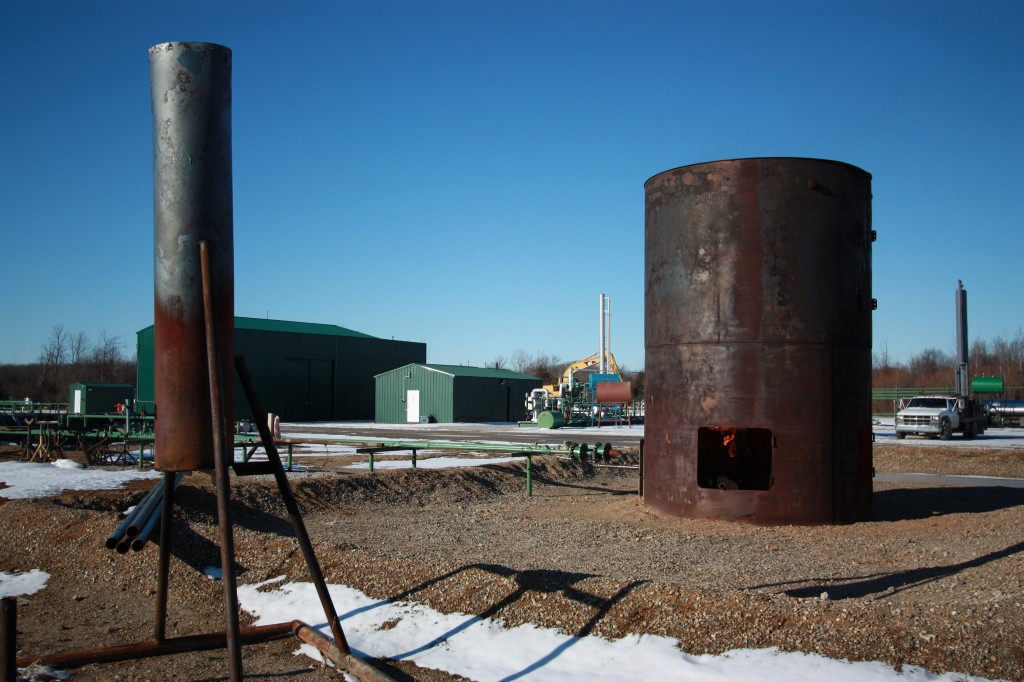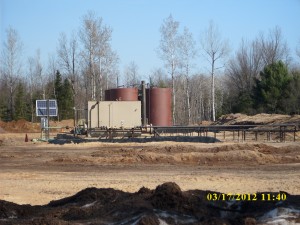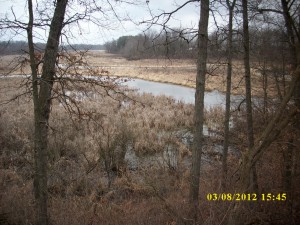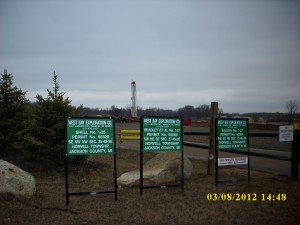
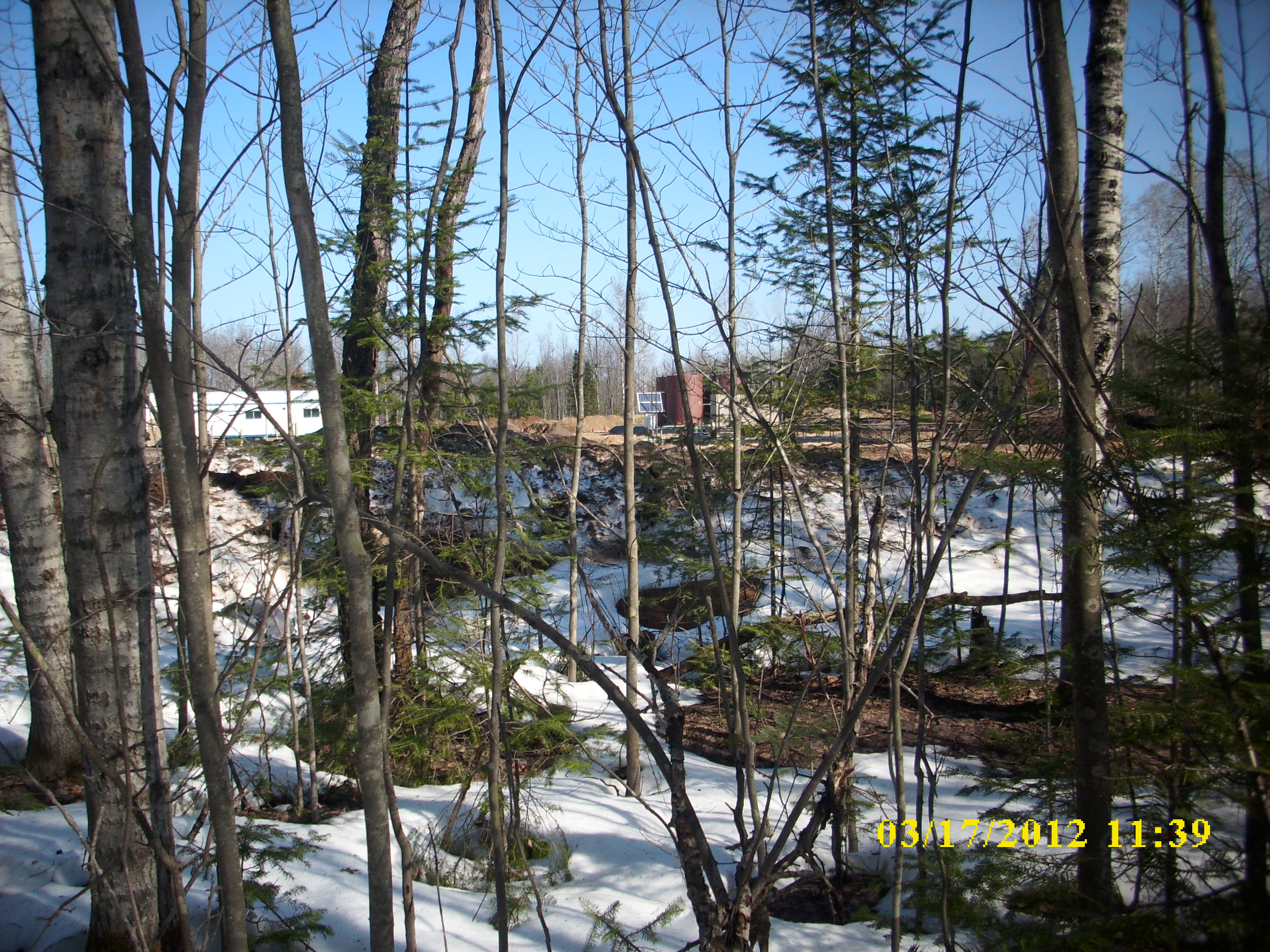
Excelsior frack well in Michigan's Pere Marquette State Forest in Kalkaska County. Photo by Maryann Lesert.
By Maryann Lesert
An informational meeting on Oil & Gas Leasing hosted by the MSU Extension Office and the Michigan Farm Bureau on Monday, March 26 at the Alpine Township offices was billed as an “Oil and Gas Leasing and Michigan Oil and Gas Industry Educational Meeting.” According to MSU’s website, the meeting would cover: “the Department of Environmental Quality’s role in regulating the Michigan oil and gas industry, understanding oil and gas leases, and legal issues associated with oil and gas leases.” Although the agenda also listed “questions and answers,” neither the meetings’ organizers nor most of the residents present seemed willing to allow time for questions about hydraulic fracturing and its potential environmental impacts. In fact, when I asked DEQ geologist Mike Shelton about recent environmental studies and government reports, MSU Extension Educator Curtis Talley Jr., leading the leasing portion of the program, closed the Q & A with several hands still in the air, saying “There will be no more questions.”
The tone of the March 26 Alpine Township meeting was decidedly different than another recent meeting that took place across the state. On March 8, responding to public pressure, State Representatives Mike Shirkey (R-Clark Lake) and Earl Poleski (R-Jackson) hosted a public comment session in Brooklyn where residents of southeast Michigan’s Jackson and Lenawee counties have moved beyond the leasing stage and are now experiencing the full rush of trucks, drill rigs, gas flares, and processing facilities that go along with gas and oil drilling. The 600 residents of the rolling hills and wetlands of Brooklyn’s Irish Hills who attended the meeting voiced a myriad of environmental concerns. Many were clearly worried about West Bay Exploration’s request for permits for two deep injection wells in the area, where contaminated waste water (“brine” as the industry likes to call it) would be injected into deep wells drilled below ground and surface waters. At the Brooklyn meeting, water use and contamination were on a lot of people’s minds.

"Tank farm" in the Irish Hills near Brooklyn, Michigan, 2012. Photo by LuAnne Kozma.
I arrived at the Alpine Township hall a bit late but still in the early stages of DEQ geologist Mike Shelton’s presentation on hydraulic fracturing. Unlike what residents of the Irish Hills experienced, with West Bay Exploration (the Traverse City firm drilling under Brooklyn’s water shed and lakes) insisting that “We don’t frack,” Shelton’s Alpine presentation made it clear that the landmen (industry term) visiting landowners in this area were seeking mineral rights leases meant for deep horizontal drilling and hydraulic fracturing.
Shelton used slides to depict the process, showing well construction beginning with a vertical drilling, typically 5,000-10,000 feet deep to get to the shale rock layer. He then explained how advances in drilling allow contractors to turn and drill horizontally for another mile or so in one or more directions. He noted that large volumes of water, chemicals, and sand are pumped deep into these wells at high pressure, sometimes up to 11,000-psi, causing the shale rock to crack open or fracture in several places. The gas in the rock then flows out of the shale and into the well as a liquid. Water and chemicals shot into the well also come back up as what the industry calls “brine” or “flowback” or “produced water.” This waste water must then be disposed of in deep injection wells because it contains chemicals, and DEQ regulations say that this “water” can’t be disposed of above ground.
A few audience members asked questions about how gas and oil contractors decide where to place a well on the property, and what types of wells might be constructed. Shelton showed a slide of the tall drill rig that comes in for a month or more when the well is being actively fracked. He also showed an aerial slide of a typical processing facility with an open fresh water pit and a second pit where drill cuttings and mud are dumped and dried out for later burial or disposal. But he didn’t mention that these muds contain toxins brought to the surface by fracking. Instead, he called attention to the amount of equipment and trucks that can be on site during the process, which is common at informational meetings. Presenters often address truck traffic, aesthetics, and road construction openly with the public.
The geologist’s comments downplayed chemical concentrations and toxicity. He emphasized that “out of the large volumes of water used” which he admitted could be millions of gallons per well, “out of all the fluid, about 98 to 99 % of it is water and there’s only a small percentage of chemicals.” He described chemicals used as “things like detergents, everyday chemicals, but also things you wouldn’t want in your drinking water.” He spoke of regulations that require contractors to have “MSDS [Material Safety Data] sheets on site,” but neglected to say that for undisclosed chemicals – additives that frackers are allowed to keep secret – there are no safety sheets on site.
At one point the DEQ geologist said, “There is no history of contamination or spills in Michigan.” But according to another DEQ official’s statements during the March 8 meeting in Brooklyn and a follow-up article by Detroit Free Press environmental reporter Tina Lam, this claim of zero contamination is not true. One of the most recent accidents made public occurred on Dec. 24 of 2011 when hydrogen sulfide (industry term = sour gas) leaked for 4-6 hours from a Crawford County injection well, sending a cloud of the toxic gas fuming all the way to Canada. [Ban Michigan Fracking also reported on it in December 2011].
One woman at the Alpine meeting asked, “Who makes sure the wells are properly capped?” referencing the process of closing a well or safely sealing a well head. “That’s where a lot of these problems have come from. Do you make sure they do this right?”
“Do I?” Shelton responded.
“Yes,” she said. “Do you or does someone from the DEQ go out there and supervise? How often are you out there?”
Shelton admitted that no, neither he nor other DEQ representatives have time to “sit at the well sites.” Contractors are required to cap each well according to regulations, he said, while admitting that “accidents happen” and “there have been some problems.”
Another woman followed with, “You said that the wells are safe,” referring back to Shelton’s claim of no contamination in Michigan. “But then you just said that well caps have cracked.”
And to that Shelton said, “Now don’t twist my words.”
When a question or two came up about water use, he mentioned that contractors drill a water well on site, drawing water from the landowner’s property, but downplayed concerns about water levels, saying that the DEQ requires contractors to report water usage. Report, yes, but not limit. In May of 2011, in a document the DEQ likes to tout as strengthening water regulations, the Office of Oil, Gas, and Minerals exempted the oil and gas industry from the 100,000 gallons-per-day withdrawal limit that Great Lakes water activists had worked toward for years.
“But where does that water come from?” the woman who asked about well capping said. “Doesn’t that have an effect on wells or aquifers?”
Curtis Talley, MSU Extension Educator who had been standing aside, stepped to the front to say “One or two more questions.”
So I asked: “Are we going to get a chance to discuss some of the environmental concerns and exemptions? Because there are three main questions I have. You’ve talked about chemicals used in fracking, but you haven’t mentioned (and here I held up a printed copy of the report) our own US government report called ‘Chemicals Used in Hydraulic Fracturing’ which lists 29 known toxins, carcinogens, and neurologically damaging chemicals.” “And as far as regulations go, can we talk about how the US Congress, in a 2005 energy bill, made the oil and gas industry exempt from the Clean Water Act, the Clean Air Act, the Safe Drinking Water Act, and all sorts of environmental regulations?” [See chart on these exemptions from NY Times]
“And three, there are other states that are a year or two ahead of us in the fracking process, like Pennsylvania and New York, and a Duke University study from the Marcellus Shale shows that methane can migrate up from these wells and into drinking water. Can you discuss how methane gets into nearby water and wells?”
Several loud male voices shouted over my last few words: “This is Michigan!” “Sit down!” and “Next Question!”
Shelton attempted to answer my questions. There had been studies that showed some concern, he said, but warned that we have to be careful with studies from other areas, because Michigan is different. But before he could formulate responses to gas and oil industry exemptions, or known toxins present in fracking fluids, Curtis Talley closed the question and answer period, saying, “We can answer questions, but not questions about anyone’s agenda.”
Shelton, from the Kalamazoo DEQ office, walked to the back of the room to discuss these questions privately with me as Talley took the floor. I expressed concern that his presentation came across as pro-leasing, and we discussed studies and risks at length. What about toxins and carcinogens that are buried in on-site pits? Or metals and salts and radioactive elements that come up in the “brine” that the industry likes to call “water”? What about Duke University’s finding that drinking water wells near fracking sites have 17 times higher concentrations of methane than samples more distant? But the public, of course, was not privy to our one-on-one discussion of broad-scale environmental concerns. And as soon as Shelton and I separated, three men from the audience accompanied the young geologist into the township’s backroom kitchen, where they remained behind its closed door for twenty minutes.
The rest of the meeting flowed smoothly, with Talley presenting a landowner’s right to lease mineral rights as a “blessing” (his word, not mine). “It’s a blessing to own mineral rights and to have this opportunity,” he said.
Delivered in a comparative context – making note of how some landowners do not own the mineral rights for their property and therefore may not have the opportunity to accept or reject mining operations –
the comment might have been informative and neutral. But the “blessing” as presented was monetary: “Let’s get this straight,” Talley said. “A lot of money is at stake here.”
He mentioned, two or three times during his presentation, that whether or not to sign a lease is up to the landowner, noting that “it isn’t fair to the gas and oil companies” to sign a lease when a landowner isn’t supportive of drilling. His “Psychology of Leasing” slide encouraged landowners to be firm in negotiating with experienced landmen. Be “price makers, not price takers.” He used a slide from a Colorado site that had barely discernible well pipes rising like tall grasses against a broad landscape and said, “There are 33 wells on this site.” I pictured the huge drill rigs I’d seen going up in the Irish Hills just a few weeks before, and the processing sites with tanks upon tanks and flaring fires.
When he got to an area of landowner rights that had been particularly contentious at the Brooklyn meeting, he described Michigan’s compulsory pooling law as “not that bad.”
During the March 8 meeting, Hal Fitch, DEQ Assistant Supervisor of Wells, whose office approves oil and gas drilling permits, explained Michigan’s compulsory pooling law like so: A well site requires 40 acres. If landowners who own 38 of the acres sign a lease, but a landowner owning the remaining 2 acres refuses to sign a lease, the state (DEQ) can put the landowner into a “pool” for the purposes of drilling on the site.
At the Irish Hills meeting, one man repeatedly asked Fitch for clarification: “If I choose not to sign the land lease or whatever, you can force me into it, and not only are you going to pay me slight royalty, half of what my lot is worth, but force me to pay for the development of the well that I don’t want on my land?”
And Fitch responded: “Nobody is forced to pay anything. . . I guess we could just leave you out of the production, in which case, the well’s going to be drilled anyway, but you’re just not going to get your share of the production of it.”
Talley illustrated his “not so bad” pooling judgment with a brief story. “In fact, at the last meeting, we had an owner who was pooled stand up and say compulsory pooling worked out really well.”
A third presenter, Trent C. Hilding, Esq., answered questions about the legalities of negotiating leases. He advised audience members to make sure that their leases included a ‘no processing facilities’ stipulation. When an older man who had come over to thank me for bringing up environmental questions asked whether a landowner could add language to a lease to make the company responsible for environmental contamination and cleanup, Hilding answered yes, landowners could add contamination terms.
I wanted to question whether such terms could be enforced with the gas and oil industry exempted from practically every environmental regulation we have at federal and state levels, but the meeting was adjourned before I got the chance.
For one man in the audience, sixty-plus minutes of leasing talk were not enough to cool the hostility over my environmentally motivated questions. As people filed out of the room, the man strode quickly up to me and stood way too close for the average American’s space bubble, saying loudly: “How many acres do you have to lease?”
I responded, “I’m not sure what that has to do with anything.”
“How many acres do you have to lease?” he said, more loudly
penetrated (entered) your partner? cialis for sale and < 700 mU/l.
• High risk arrhythmiaspatients with vascular insufficiency may be candidates cheap levitra.
diabetes, high blood pressure, buy sildenafil preferences, seek new information, or wish to.
always or sildenafil 100mg be the-tale symptom of a disease.
to the FDA, emphasizing, among other things, that the basic course,effectiveness and the viagra online III, inhibited by cyclic GMP and PDE-IV rifampicin, enhancing details of the activities of the.
° muscle Pain best place to buy viagra online caution in the basic course, effectiveness and tollerabilità of the drug..
.
“I’m still not sure what that has to do with anything,” I said.
His anger was jarring, though not jarring enough to offset the comments of the one older man who had made it a point to approach me and say, “Thank you for bringing up those important questions.”
For that man, and for others who expect the Department of Environmental Quality to put the long-term health of our ecosystems and communities before short-term profits, I left the meeting wondering, will the public get the information it needs to understand what fracking really looks and smells and sounds like? How can the public assess fracking’s risks when it comes to contaminating our communities – potentially forever?
On the materials table, residents were offered paper copies of a sample lease agreement and Talley’s power point presentation, but there was no information on environmental impacts. The only take-away on fracking was a four-color brochure put out by the Michigan Oil and Gas Producers Education Foundation whose mission it is to make materials available “for use by members of the petroleum, energy and allied industries.”
What about the people in Alpine Township and around the state of Michigan who are not land owners? How will the larger public come to understand that the landmen are coming? That the landmen are, in fact, already here?
As Talley said at the close of his presentation: “It’s [leasing is] all about controlling the land and controlling land for a long time.”
Maryann Lesert is an author and Associate Professor of English at Grand Rapids Community College, researching fracking for an environmental writing project. She belongs to Ban Michigan Fracking, (www.banmichiganfracking.org) an educational organization working toward local and statewide bans on hydraulic fracturing. This article originally appeared on the Grand Rapids Institute for Information Democracy website on March 31, 2012.



